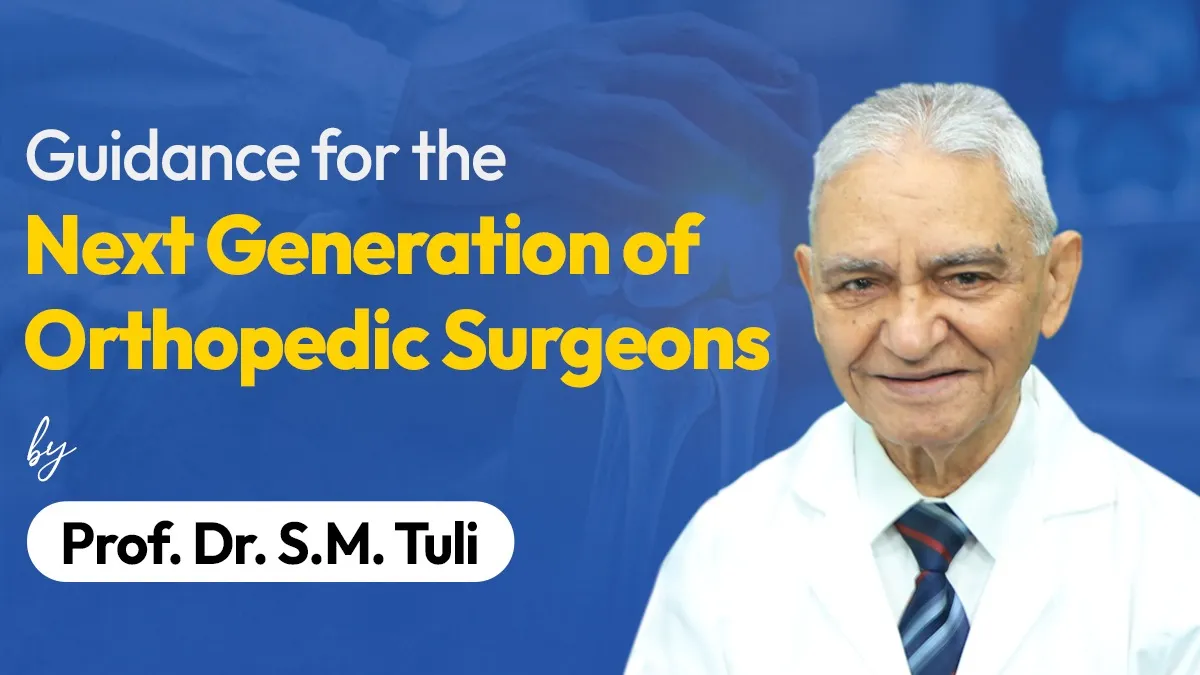Estimated reading time: 3 minutes
The world of orthopedics welcomes a new generation — sharp, eager, and driven to make a difference. In a heartfelt and powerful message, Prof. Dr. S.M. Tuli, one of India’s most respected orthopedic minds, addresses young orthopedic surgeons stepping into this vast and dynamic field. His words are a blend of experience, encouragement, and timeless guidance.
Orthopedics is not just a specialty — it’s a family. A family bound by the common task of taking care of one of the body’s most complex and far-reaching systems. From the vertebral column to the limbs, from nerves and muscles to bones and joints, orthopedics is the art and science of movement, support, and structure.
Knowing the Scope: Traumatic & Non-Traumatic Orthopedics
Orthopedics is not only about bones; it’s about knowing the story behind each injury and illness. Prof. Tuli stresses that the area encompasses largely:
- Traumatic Orthopedics – Fractures, dislocations, simple and complex injuries, and management of polytrauma patients.
- Non-Traumatic Orthopedics – Infections, deformities, tumors, congenital anomalies, degenerative diseases, and neurological disorders.
Each case is a puzzle that needs clinical skill and empathetic handling.
Clinical Examination: The Cornerstone You Should Never Overlook
In a time of high-tech imaging, Prof. S.M. Tuli underscores the irreplaceable importance of clinical examination. Technology may be helpful but cannot substitute for the intelligence acquired by:
- Listening to the patient
- Feeling and observing the affected part
- Measuring and comparing limbs
- Employing comparative X-rays as necessary
These steps don’t merely disclose physical evidence — they forge an essential doctor-patient relationship.
Learning the Essentials: Splints, Plasters, & Functional Positions
For new graduates, it’s all about becoming proficient at the fundamentals of orthopedic care — selecting the correct splints, knowing the optimal position for plaster, and identifying functional positions for all joints. These concepts are the foundation of initial orthopedic treatment and rehabilitation.
Procedures & Operative Learning: Observe, Assist, Read
You will move on to injections, aspirations, and surgical procedures as you mature. Dr. Tuli’s advice? Learn modestly and with an inquiring mind:
“Watch it today, help your mentor, return home and read it in the book.”
This “watch, help, read” cycle is a tried-and-true recipe for clinical development.
A Journey Through Imaging: From X-rays to MRI
Reminiscing about his own experience, Prof. Tuli describes how, until 1987, X-rays were the sole imaging modality in the majority of Indian environments. He himself learned MRI by spending months at the center, sitting next to experts and posing questions.
He streamlines MRI interpretation with a golden mnemonic:
T2 = Water White
It assists in remembering how fluid appears on various sequences — a crucial ability when diagnosing trauma, infection, or inflammation.
There Is No Upper Limit to Learning
There is no limit to knowledge. The discipline is moving into 15+ orthopedic super-specialties, from spine surgery to pediatric orthopedics. But in order to specialize well, you need to first establish a good foundation in general orthopedics. A solid foundation provides a stable peak.
Conclusion:
This message is not just advice — it is a philosophy. An invitation to remain humble, stay curious, and commit oneself to a lifelong journey of learning.
“If your base is strong, the pyramid top will be strong.”
As you embark on or continue your orthopedic journey, may you take these words with you, humility in your heart and excellence in your hands.

